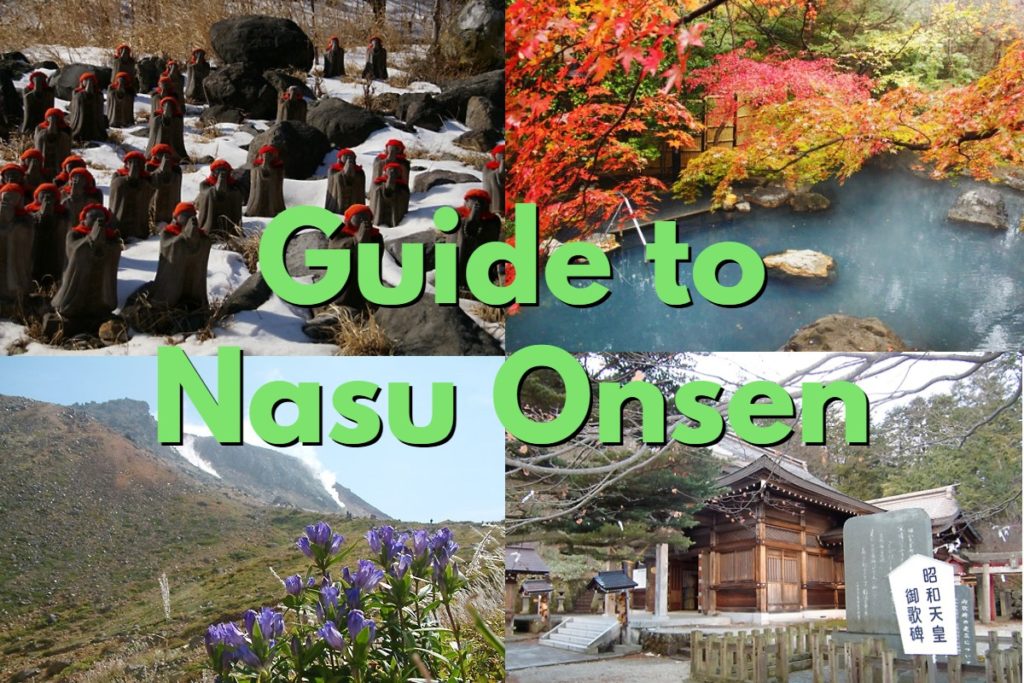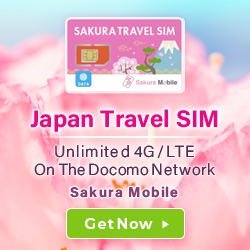Photos courtesy of Nasuonsen Sanraku (top right) and Nasu Tourism Association
Nasu Onsen is an area located in the mountains of Tochigi Prefecture. Boasting different types of hot springs and all sorts of tourist attractions, Nasu Onsen is known among locals as a peaceful and relaxing getaway area. In this article, we will be providing you with a complete guide to the Nasu Onsen area.
This guide will include our recommended lodges for staying in Nasu, the best places to eat, and our favorite locations for sightseeing.
Let’s get started!
Have you booked your SIM card or pocket WiFi for your trip to Japan yet?
In Japan, you’ll want to be connected without missing out on high speed data and internet!
By reserving online before departing, you can
- Lower your rental fees
- Avoid stock shortages at the airport
To learn more about data and WiFi options for your trip, check out our products below.

Hello readers! Sakura Mobile is a SIM & WiFi service provider for international residents and tourists in Japan.
Our global editorial team living in Japan will introduce the charms of the country based on what we have actually experienced and felt.
Table of contents
- What kind of place is Nasu Onsen?
- How to enjoy Nasu Onsen
- Ryokan and hotels at Nasu Onsen
- Places to visit – Nature spots
- Places to visit – Museums and activities
- Food and restaurants in Nasu Onsen
- A sample itinerary for an overnight trip to Nasu Onsen
- When to visit Nasu Onsen
- How to get to Nasu Onsen
- Nasu Onsen map
- Things to keep in mind
- Conclusion
1. What kind of place is Nasu Onsen?
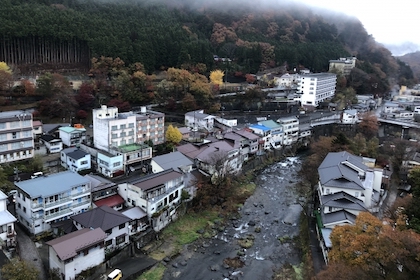
Nasu Onsen is located in the northern part of Tochigi Prefecture, which is about an hour and a half north of Tokyo. It is said to have been discovered back in the Asuka Era (the early 600s), making it a perfect location for those who are interested in Japanese history.
From its discovery to the present day, there are a series of hot springs that continue to be discovered in the area. This abundance of different hot springs brings in many people, and Nasu Onsen gets a total of over 4 million visitors yearly.
When you hear the word onsen, you might immediately think of the more popular onsen towns like Hakone or Kusatsu; Nasu Onsen is a bit different from these locations in the fact that everything is not concentrated in one specific area. However, there are still many areas for sightseeing worth checking out, which we will go over later in the article.
↑ Go back to the table of contents
2. How to enjoy Nasu Onsen
There are three major selling points of Nasu Onsen. Below, we have included a breakdown of some of the recommended ways to enjoy Nasu Onsen.
Go on a nature walk

Nasu itself is located on a mountain, making it a popular hiking spot. For those who are tired of the busy city life or are feeling the need for an escape, we recommend Nasu for its tranquil forests and sprawling views of nature.
Later in this article, we will be introducing different areas where you can best explore the outdoors of Nasu.
Try out the different types of hot springs
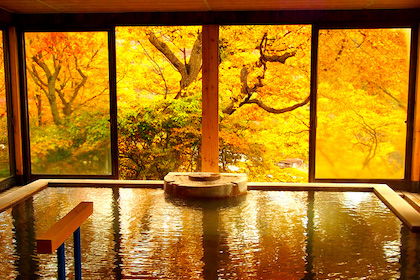
Nasu is famous for the many types of hot spring waters. During the early modern period of Japan, Nasu was known for 7 major hot springs, but in recent years even more have been discovered.
Different ryokan at different locations in the area will be using different waters, and exploring more will lead you to find public baths that you can stop by and use without having to spend the night. Taking advantage of all the different types of onsen would be a relaxing way to spend a day in Nasu.
Attend seasonal events
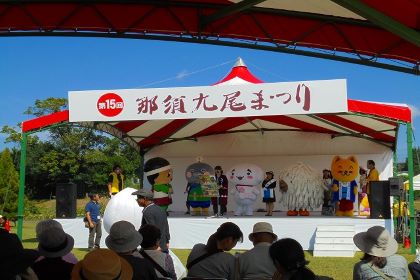
One of the best characteristics of Nasu is that you can enjoy something in the area all year round! With a multitude of festivals year-round there is always something going on that you can look forward to.
Of course, because Nasu’s beautiful scenery is its strong point, you will be able to see tulips and other flowers bloom in the spring and summer, as well as the changing of the leaves in the fall. Being on a mountain, you can also go skiing in the winter; there is a ski resort for those interested.
↑ Go back to the table of contents
3. Ryokan and hotels at Nasu Onsen
The following are some of the best places to stay while you are in Nasu Onsen. We have included lodges of all different types, from traditional-style Japanese ryokan to more modern hotels.
Nasuonsen Sanraku (那須温泉 山楽)
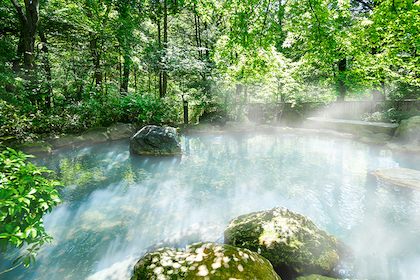
With a history dating back to 1923, Nasuonsen Sanraku continues to value the tradition of Japanese hospitality when serving its guests. The emperor of Japan visited this ryokan shortly after its establishment, setting an example of high quality for many years to come.
The rooms as well as the public bathing area are very spacious and give off a relaxing vibe. Some rooms come with a private onsen attached, so we recommend taking advantage of that if it is within your budget. As for the public bath, it is especially beautiful in the fall with the leaves changing colors.
Information
- Price: Starting from around 35,000 JPY per person/night
- Address: 206 Yumoto, Nasu, Nasu District, Tochigi 325-0301 (Google MAP)
- # of Rooms: 39
- Large Public Bath: Available
- Private Rental Bath: Not available (But you can rent a suite with a private bath)
- Visit Official Site
NASU ICHIYA HOTEL (那須いちやホテル)
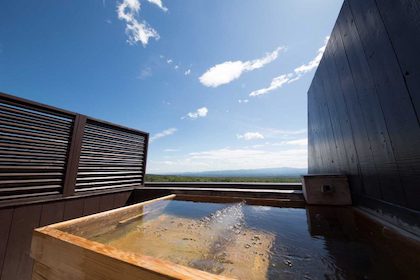
NASU ICHIYA HOTEL is one of the more affordable luxury ryokan that you can find at Nasu Onsen. The hotel’s mission is to provide guests with an experience that is both fun and feels like home.
Additionally to the public bathing area, there is a private onsen available for rent. You can use it for 40 minutes at a time. It is located at the top of the building and is free to use (as long as no one else is in it, of course) between the early hours of 5:30 to 9:30 am so you can enjoy the sunrise from the bath.
Information
- Price: Starting from around 13,000 JPY per person/night
- Address: 204-14 Yumoto, Nasu, Nasu District, Tochigi 325-0301 (Google MAP)
- # of Rooms: 28
- Large Public Bath: Available
- Private Rental Bath: Available
- Visit Official Site
ONSEN RYOKAN Yamaki (ONSEN RYOKAN 山喜)
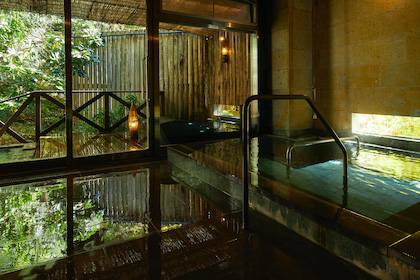
ONSEN RYOKAN Yamaki aims to give guests a relaxing getaway from the stressors and hectic activities of daily life. For those who are interested in the specific types of hot spring waters, ONSEN RYOKAN Yamaki is one of two ryokan that uses Itamuro Onsen water, a hot spring specific to Nasu.
If you are staying at ONSEN RYOKAN Yamaki, we recommend that you eat at the ryokan for at least one of your meals. You can find a traditional Japanese restaurant that uses fresh seafood and vegetables. There is also a fancy bar if you are looking to grab a drink after dinner.
Information
- Price: Starting from around 20,000 JPY per person/night
- Address: 844 Itamuro, Nasushiobara, Tochigi 325-0111 (Google MAP)
- # of Rooms: 8
- Large Public Bath: Available
- Private Rental Bath: Not available (But you can rent a suite with a private bath)
- Visit Official Site
Nenn NASUKOUGEN
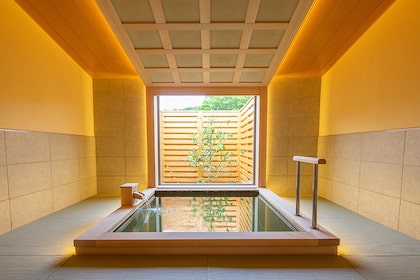
Nenn NASUKOUGEN is a bit different from the other lodges on this list because it is not an indoor hotel. Nenn NASUKOUGEN is a camping ground (“glamping,” if you will) that offers a total of 17 large tents for visitors.
We recommend Nenn NASUKOUGEN for those traveling with children or with a large group of friends because of the fun atmosphere. You can cook your own dinner and enjoy the outdoors in the company of your friends, family, and other campers.
When you think of “camping” you may not assume “onsen,” but there is actually a public and a private onsen. The private onsen is a rentable one, so the onsen experience is no different from that of a regular ryokan or hotel.
Information
- Price: Starting from around 20,000 JPY per person/night
- Address: 5461-1 Takakuko, Nasu, Nasu District, Tochigi 325-0304 (Google MAP)
- # of Rooms: 17
- Large Public Bath: Available
- Private Rental Bath: Available
- Visit Official Site
↑ Go back to the table of contents
4. Places to visit – Nature spots
Nasu has some of the best spots in Japan for enjoying the outdoors. If you are interested in hiking or just taking some time to relax and enjoy a view of forests and mountains, we have some suggestions for you.
Momijidani Suspension Bridge (もみじ谷大吊橋)
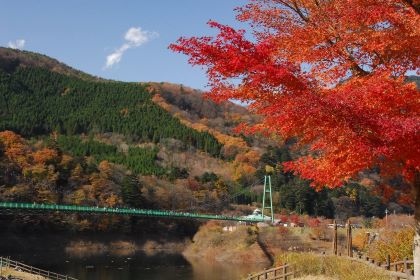
The Momijidani Suspension Bridge is located on the eastern side of the Nasu Onsen region. It is a popular spot for “kouyou,” or the observation of the colorful leaves of autumn. The bridge is 320 meters long, high up, and has a spectacular view of the surrounding forests. With an area for food and shopping at one end of the bridge, the Momijidani Suspension Bridge is the perfect place to make a rest stop and enjoy the scenery.
Along with being a pretty nature spot to visit, Momijidani Suspension Bridge has been nominated as one of the most romantic spots in Japan. You might choose to come here if you are thinking about proposing to your significant other.
Information
- Price: 300 JPY/person
- Hours of Operation: 8:30 am – 6:00 pm (until 4:00 pm in the winter months)
- Visit Official Site
Sesshoseki (殺生石)
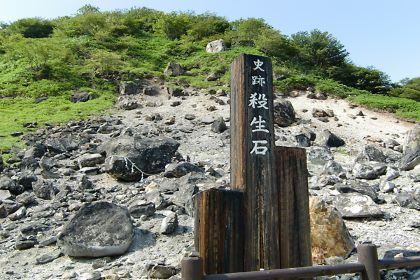
Myths of a nine-tailed fox spirit are still told to this day in the Nasu area. It is said that after terrorizing people in China and India, the fox made its way to Japan where attempts to seal it away failed; the fox turned itself into the stones that are now known as the Sesshoseki. Because of the volcanic gases emitted in the area, it was said for many years that the Sesshoseki still released poison that would kill people and birds that came near.
You will be able to smell the strong scent of sulfur when you arrive. It is not too crowded, but it is a popular tourist spot so you may want to be careful visiting during the prime times on the weekends.
Mt. Chausu (茶臼岳)
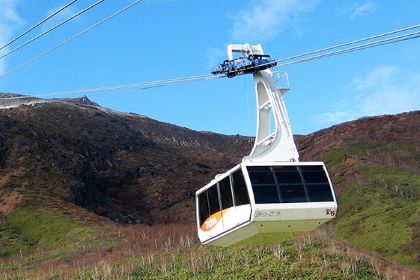
For those interested in hiking, we suggest Mt. Chausu for your trip to Nasu. There are multiple trails to go up the mountain, some easier than others. This makes it so that the whole family can enjoy the hike together. Mt. Chausu is a windy mountain, so make sure to bring layers of clothing.
Even if you do not feel up to climbing a mountain, there is a cable car that runs up Mt. Chausu so you can enjoy the peaks without having to make the journey. This is a good choice for those traveling with very young children or senior citizens.
↑ Go back to the table of contents
5. Places to visit – Museums and activities
Nasu may have you fooled for just a pretty nature spot, but there are more things to do than you might think. Nasu is a must-visit if you frequent museums, as there are a large number of them all with unique themes. Below, we have listed several said museums as well as other activities that might pique your interest.
Shikanoyu (鹿の湯)
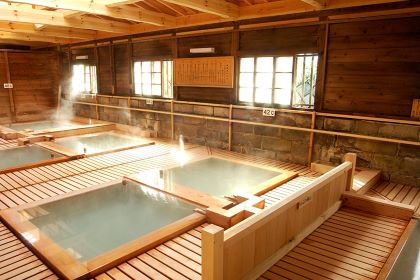
Shikanoyu is the oldest onsen in Tochigi Prefecture, discovered in the 7th century. The building was renovated once in 1941 and has remained the same since. Visiting this establishment will make you feel as if you have wandered into ancient Japan and is the perfect place to experience the onsen culture.
Shikanoyu is a public bath, separated into men’s and women’s areas. The temperature of the different baths ranges from 41 to 48 degrees celsius, so be careful when getting in, as some of the waters may be extremely hot (for your reference, the average hot tub is about 38 degrees Celcius).
Information
- Price: 500 JPY/person
- Hours of Operation: 8:00 am – 6:00 pm
- Visit Official Site
Nasu Highland Park (那須ハイランドパーク)
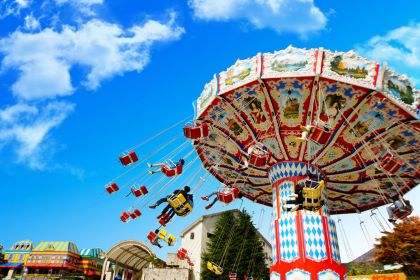
If you are looking to spend some time out with the family, Nasu Highland Park is an exciting option that will keep you busy for the whole day. You may not expect a rural area like Nasu to have a large-scale amusement park, but Nasu Highland Park has an endless amount of attractions and rides such as roller coasters, water rides, and VR. Some events happen year-round that including listening to live music or meeting exotic animals.
Nasu Highland Park is no Disneyland, but you will be relieved to escape the long lines and crowded restaurants while still getting a high-quality amusement park experience.
Information
- Price: 1,600 JPY/person (5,600 JPY for a free pass to all the rides)
- Hours of Operation: 10:00 am – 4:30 pm
- Visit Official Site
Nasu Stained Glass Museum (那須ステンドグラス美術館)
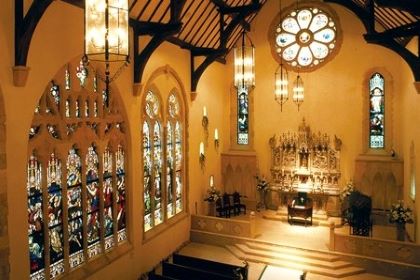
The Nasu Stained Glass Museum is a relaxing museum located in the central area of Nasu. The building itself is a western-style manor, aesthetically fitting for the stained glass inside. There is also a chapel that you can rent for 30 minutes for a proposal or even a whole day for an entire wedding ceremony. You can sometimes hear organ performances, which helps to bring out the atmosphere of the museum even more.
z
For a small extra fee (starting at 1,200 JPY), you can create your own trinket made out of stained glass. Even young children can enjoy the stained glass classes, so you can rest easy knowing the whole family can participate.
Information
- Price: 1,300 JPY/person
- Hours of Operation: 9:30 am – 4:30 pm
- Visit Official Site
Nasu Teddy Bear Museum (テディベアミュージアム)
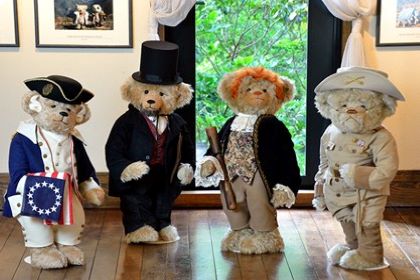
The Nasu Teddy Bear Museum is quite possibly one of the cutest museums you will ever visit. As you might imagine, the museum features a large collection of stuffed bears, from antique bears to bears from all around the world. You might find that teddy bears have a lot more history than you would have initially thought.
At Nasu Teddy Bear Museum there are many places specifically made for the purpose to take pictures with the teddy bears; these spots might make the perfect family photo or social media post.
Information
- Price: 1,350 JPY/person
- Hours of Operation: 9:30 am – 5:00 pm
- Visit Official Site
Nasu Trick Art Museum (那須とりっくあーとぴあ)

Nasu Trick Art Museum is actually an area made up of three separate museums. They all feature what is called “trick art,” paintings that include optical illusions. Rather than just looking at the artwork, posing and taking funny pictures is arguably the most prominent selling point. This makes the exhibits fun and much more interactive than your average art museum.
To enjoy Nasu Trick Art Museum to the fullest, we recommend that you explore all three of the buildings. If you have the time in your schedule, it would likely be worth it to buy the ticket that will give you access to all three museums (2,800 JPY).
Information
- Price: 1,300 JPY (access to one building) to 2,800 JPY (access to all three buildings)
- Hours of Operation: 9:30 am – 6:00 pm
- Visit Official Site
↑ Go back to the table of contents
Have you booked your SIM card or pocket WiFi for your trip to Japan yet?
In Japan, you’ll want to be connected without missing out on high speed data and internet!
By reserving online before departing, you can
- Lower your rental fees
- Avoid stock shortages at the airport
To learn more about data and WiFi options for your trip, check out our products below.
6. Food and restaurants in Nasu Onsen
While in Tochigi Prefecture, there are some foods unique to the area (even some specific to Nasu) that you should definitely not miss out on. Below are some of the specialties and where to get them.
Yakisoba in soup (スープ入り焼きそば)
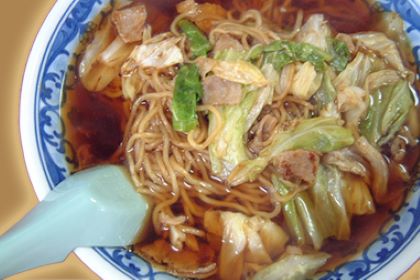
You may have heard of yakisoba before. It is a Japanese stirfry noodle dish that involves Chinese noodles, cabbage, and in many cases pork. You would usually eat these noodles with some type of sauce, but in Nasu, you can find them inside a soy sauce-based soup. Putting these noodles in soup is very unusual, and there are not many other places where you can eat this.
Kobaya Shokudou is one of the restaurants with the longest history of yakisoba in soup. It is a very popular spot, so be sure to line up early if you are thinking of going.
Information
- Name: Kobaya Shokudou (スープ入り焼きそば こばや食堂)
- Price: Starting at 700 JPY
- Hours of Operation: 11:00 am – 2:30 pm
Shimotsu curry (しもつカレー)
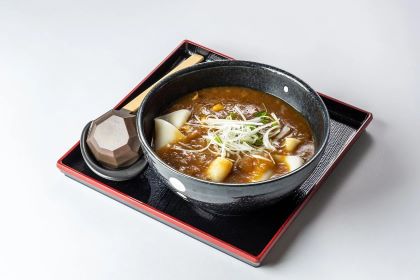
Shimotsu curry is a mix of two foods. One is simply Japanese-style curry, and the other is something called, “shimotsukare.” Shimotsukare is a dish local to the northern Kanto region of Japan (where Nasu is located) that is made by mixing and simmering vegetables, soybeans, deep-fried tofu skins, and rice pulp from sake. Because the words “curry” and the end of “shimotsukare” are nearly the same, a new type of food was born in Nasu.
Nasu’s shimotsu curry involves both the ingredients of Japanese curry and shimotsukare. It is an “anything goes” type of dish and has been paired with all sorts of foods such as Japanese noodles and even pasta. At the restaurant below, Eitarou, you can eat shimotsu curry with udon.
Information
- Name: Eitarou (榮太楼)
- Price: Starting at 900 JPY
- Hours of Operation: 8:30 am – 6:00 pm (Closed on Wednesdays and Thursdays)
- Visit Official Site
Toteyaki (とて焼)
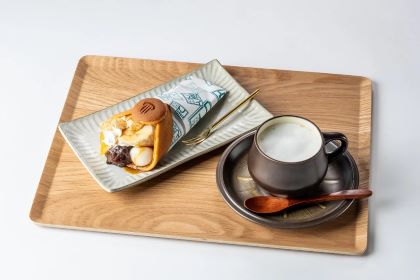
At first glance, toteyaki looks like a crepe. However, the dough is on the thicker side and has the consistency of a pancake or castella. Fillings include all sorts of sweets (or occasionally savory ingredients) depending on where you get them.
The information for the shop we have included below sells toteyaki with kuromitsu (a brown sugar-based sweet sauce) and kinako (a powder made out of soybean). We suggest you try this because it includes so many Japanese ingredients. If you are interested in the classic fruit and whip cream taste, however, many other shops sell toteyaki in Nasu. Each shop is different, so if you like sweets it would be wise to try all the different kinds of toteyaki.
Information
- Name: Imaiya Seika (今井屋製菓)
- Price: Starting at 450 JPY
- Hours of Operation: 6:30 am – 5:00 pm
- Visit Official Site
↑ Go back to the table of contents
7. A sample itinerary for an overnight trip to Nasu Onsen
We have compiled an example of a two-day, one-night trip to Nasu Onsen from Tokyo. We hope that you will use it as a reference to plan for your adventure.
(Day 1)
8:00~
- Leave Tokyo and head to Gunma by local train
- Take the shuttle bus from Kuroiso Station to Nasu Onsen
11:00~
- Check into your hotel or ryokan
- Drop off your luggage and get settled in
12:00~
- Have Shimotsu curry for lunch
13:00~
- Visit some of the nature spots like the Sesshoseki and the Momijidani Suspension Bridge
18:00~
- Eat a traditional Japanese dinner at the hotel
19:00~
- Find a local izakaya (Japanese pub) in the area and grab some drinks
20:00~
- Use the public bathing area
- Relax in your room and go to bed
(Day 2)
8:00~
- Eat breakfast at your lodge or go into town to find something to eat
- Take a morning bath
10:00~
- Check out of your hotel
- Leave your luggage at the hotel to lighten the load you have to carry
12:00~
- Eat yakisoba in soup for lunch
13:00~
- Visit some of the museums
15:00~
- Find a place nearby that sells toteyaki to have as a snack
16:00~
- Visit any tourist spots that you have left over
18:00~
- Eat dinner at a local restaurant before you have to go home
19:00~
- Head back to Tokyo
↑ Go back to the table of contents
8. When to visit Nasu Onsen
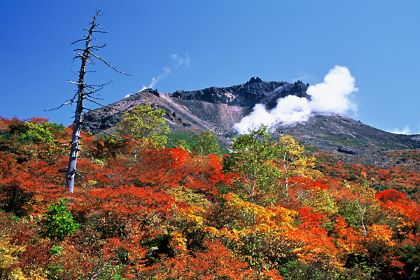
As mentioned earlier in this article, there are places to go and things to see in Nasu regardless of the time of year you visit.
There are festivals during some times of the year so you may want to time your visits accordingly. You may find that festivals that you can experience in rural Japan are different from the crowded and bustling ones in the inner city.
For those who have a particular interest in festivals, we recommend going in the summer, when the Rindou Lake Fireworks Show and the Kyuubi Matsuri occur. The Rindou Lake Fireworks Show is a large display over the lake, and the Kyuubi Matsuri is a Japanese festival celebrating mythology specific to Nasu.
↑ Go back to the table of contents
9. How to get to Nasu Onsen
Traveling from Tokyo
From Tokyo station, you can take the bullet train and then a bus from the station to Nasu Onsen. Depending on the season, it can cost you up to 11,000 JPY. There are also times when the bullet train is cheaper, so make sure you check before buying tickets.
It is possible to take local trains to Nasu from Tokyo, but it will take you about 3 hours. This is one of the cheapest options, however, at just over 3,000 JPY.
Another cost-effective way to get to Nasu is by reserving a bus. These buses depart from the bus station at Shinjuku Station and will take you around 3 hours and 20 minutes. Depending on the season, this can potentially be the cheapest way to get to Nasu. It is also recommended for those who do not want to figure out complicated train transfers as it will take you directly to your destination.
Traveling from Osaka/Kyoto
Because Nasu Onsen is quite a distance from the western part of Japan, it will take you considerably longer and will be more expensive if you are traveling from Osaka or Kyoto. You will be looking at a bullet train ticket for around 18,000 JPY and then another 1,000 JPY to ride a bus up the mountain.
Another option is to get a rental car and drive to Nasu. This will also take a considerable amount of time and money, but a fun possible option if you are traveling with a group of friends with driver’s licenses.
↑ Go back to the table of contents
10. Nasu Onsen map
Below is a map that includes all the places that we introduced in this article. We hope that it comes in handy during your trip to Nasu Onsen.
↑ Go back to the table of contents
11. Things to keep in mind
Think about using a rental car
Unlike other onsen towns, not everything in Nasu is located in the same general area. Whereat other locations you may have the option to just explore the town on foot, Nasu is a little more difficult. Of course, Nasu is not devoid of public transportation and you will be able to find buses to get you where you need to go.
However, you will find by looking at Google Maps that it will sometimes take you close to an hour to get to some locations where a car would have gotten you there in less than 20 minutes.
For this reason, we recommend getting a rental car. It will make traveling much easier and you will not have to plan your schedule around the buses, giving you the freedom to visit the places you need.
For those with tattoos
The general image of tattoos is shifting as more international travelers visit and start to settle down in Japan. However, keep in mind that Nasu is still a very old-fashioned area of Japan, and there are generally many lodges that will not let you enter the onsen if you have tattoos.
If you have tattoos and still want to experience the onsen culture, we recommend finding a hotel that allows tattoos, has a private onsen that you can use, or offers cover-up stickers that you can wear into the bath.
Have cash on you
Being a rural area a ways from the city, the Nasu area is not quite out of the habit of using cash. Although there will be shops that do take card and other forms of cashless payments, you should keep a good amount of cash on hand just in case.
Note that there will most likely not be many places to exchange currency, so be sure to get all the cash you will need before departing for Nasu.
↑ Go back to the table of contents
Conclusion
What did you think?
For those who have yet to get a taste of Japan’s rural areas, Nasu is highly recommended. Beautiful at any time of year and with an abundance of tourist attractions, it can be a perfect vacation spot for those of all age groups.
While many people flock to the very popular tourist destinations and crowded onsen towns, we think that you should give Nasu a try if you want to visit a less populated and more calm area of Japan.
Enjoy your trip to Nasu!
Have you booked your SIM card or pocket WiFi for your trip to Japan yet?
In Japan, you’ll want to be connected without missing out on high speed data and internet!
By reserving online before departing, you can
- Lower your rental fees
- Avoid stock shortages at the airport
To learn more about data and WiFi options for your trip, check out our products below.

